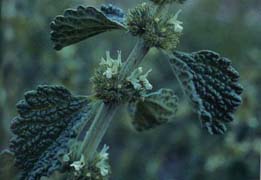Healing Gardens
Marja Eloheimo
Fall 2006
Longhouse Garden Site Description Guide
Area Name: Mixed Forest A & B
Habitat Type(s) Represented: Forest Understory
Student Names: Suzanne Robinson & Megan Fuller
Date Completed: _________________
I. Overview (This consists of a qualitative narrative description of your observations.)
Divided almost in half by a woodchip trail, most of mixed forest A lies on flat land, which
slopes up slightly on the side of the trail farthest from the longhouse. On the farther side
grow a few maples, as well as many fir trees. The understory is almost entirely covered
by ivy, which is beginning to climb up a couple of the trees. On the inner side of the trail, closest to the footpath and longhouse, the predominant plant that grows is the fern.
From the start of the footpath to just past where it begins to curve is relatively barren
aside from some labeled plants. After the curve in the path, the inner corner of Mixed
forest A (closest to the longhouse) is lush with multiple types of small, low-growing
plants, some of which resemble moss. In the back corner of MFA (farthest from the start
of the footpath), grows a cluster of trees so close together that the roots intertwine. Underneath, the ground slopes steeply down to meet the yardwaste piles. The
understory includes many low-growing bushes of sharp-leaved plants which produce
purple berries.
II. Describing the Garden Site
1. Map & Size (draw a map; measure sides; calculate approximate area)
(Refer to Attachment below)
2. Shape (use descriptive words such as oval, long & narrow, etc.):
Mixed forest A is nearly triangular with rounded corners. There is a dirt trail through the area that is U shaped, and cuts the area into an oval merging with a circle.
3. Topography (use appropriate adjectives such as flat, uneven, undulating, etc.):
Mixed forest A is slightly sloping downward from the street, or upward from the Longhouse building. Compared with the surrounding areas, it is relatively flat and easy to navigate.
4. Slope(s) (estimate the percentage away from level) and Orientation(NSEW):
5. Exposure (estimate how many hours per day you think the area gets sun):
Mixed forest A receives most of the sunlight through the tree canopy of the fir trees and large maple trees. As the area nears the bottom of it’s slight hill, there is less canopy for the sunlight to compete with, so that area has more variety of plants and lush ground.
6. Soil characteristics:
Texture (sandy, clay, loam, etc.)
Color
Consistency (firm, loose)
Drainage (well, poor)
7. Water Features (if any: type, width, length, depth, velocity, seasonality):
Mixed forest A has no significant water features (other than the couple of sprinklers installed)
8. Principal Plant Species present:
(Include estimated abundance (little, moderate, a great deal) and stage of growth or
approximate size (small, young, seedling, 4 feet tall) and quality (healthy, robust, sickly, etc.)
|
Plant Name |
Abundance | Stage of Growth/Approx. Size | Quality |
| Big Leaf Maple |
Little Moderate A Great Deal |
Small Seedling Young ____ft tall | Healthy Robust Sickly _______ |
| Ocean Spray |
Little Moderate A Great Deal |
Small Seedling Young ____ft tall | Healthy Robust Sickly _______ |
| Trailing Blackberry |
Little Moderate A Great Deal |
Small Seedling Young ____ft tall | Healthy Robust Sickly _______ |
| Sword Fern |
Little Moderate A Great Deal |
Small Seedling Young ____ft tall | Healthy Robust Sickly _______ |
| Salal |
Little Moderate A Great Deal |
Small Seedling Young ____ft tall | Healthy Robust Sickly _______ |
| Salmonberry |
Little Moderate A Great Deal |
Small Seedling Young ____ft tall | Healthy Robust Sickly _______ |
| Douglas Fir |
Little Moderate A Great Deal |
Small Seedling Young ____ft tall | Healthy Robust Sickly _______ |
9. Evidence of animal activity (nests, tracks, burrow, insects, foraging, etc):
10. Your feelings about the site. Include why you have chosen this place for your garden.
III. Your Feelings About the Site (Include what calls you to this area.)
